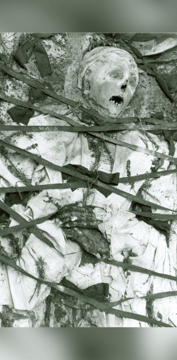Chilling Tale of a Woman Chained in Her Grave
Explore the haunting story of a woman chained in her grave, a chilling tale steeped in superstition and fear. Discover the mysteries of the unknown and the lengths taken to prevent her spirit from rising.
Billys Zafeiridis
11/11/20245 min read


In a small, forgotten village in Greece, there lies a grave unlike any other. It isn’t the weathered, moss-covered stones or the broken, barely readable inscription that catches your eye—but rather, the heavy iron chains wrapped tightly around it. Chains that were placed there long ago, not out of reverence or remembrance, but out of terror. This isn’t just a story about death, but about the primal fear of what may follow it.
To understand why a woman was chained in her grave, we need to step back into a time when the boundary between life and death felt thin and porous, a time when superstition and fear shaped the world in visceral, physical ways. In many parts of the world, people believed that certain individuals—often women who were considered outcasts or “strange”—held a dark power that didn’t fade with death. The woman in this story was one of those feared souls.
The Legend of the "Restless Dead"
In Greece, as in much of Europe, there was an ancient belief in the “restless dead.” These were people who, for one reason or another, couldn’t find peace in the afterlife and were thought to rise from their graves, haunting the living. Such souls were often believed to be dangerous, malevolent even—filled with unresolved anger or sorrow that festered beyond the grave.
According to local legend, this particular woman had been a healer, an herbalist, or perhaps simply someone who lived on the fringes of society, practicing the old ways in a time when anything unconventional was enough to incite suspicion. Some claimed she was a witch, while others whispered that she had made a pact with dark forces. Was she really capable of something sinister, or was she simply misunderstood and feared because of her difference? We may never know.
But in her village, she was considered a threat, even in death. The villagers believed that if her spirit were to rise, it would bring misfortune, sickness, or even death to those around her. So they took drastic measures. After she died, the villagers gathered with tools, iron, and chains, ready to bind her body to the earth. They dug her grave, laid her down, and wound heavy iron chains around her, making sure to secure them tightly. For good measure, they placed a large stone slab on top of the grave, meant to pin her down, body and soul.
Iron Chains and Dark Rituals
The iron chains weren’t just a random choice. Iron has long been thought to repel evil spirits and supernatural beings. People once believed that it was a metal that demons, witches, and ghosts could not cross. By chaining her down with iron, the villagers thought they were sealing her spirit within the grave, trapping it so it would never rise to haunt them.
This wasn’t the only ritual of its kind. Across Europe, tales of the dead being restrained in their graves are not uncommon. In some areas, people would drive stakes through the hearts of suspected vampires or place stones in the mouths of the deceased to prevent them from “feeding” on the living. These acts, however horrifying, reveal an undercurrent of fear that ran deep in these societies—a belief that even death might not be powerful enough to contain certain evils.
The Haunting Rumors
Not surprisingly, this extreme act of chaining a woman in her grave created an aura of dread around her burial site. Stories started to spread that strange things happened near her grave. Animals would reportedly refuse to walk near it, and people claimed they could feel a chill in the air when they passed by. Some villagers swore they heard faint scratching noises coming from beneath the earth at night, while others said they caught glimpses of shadowy figures near the grave at dusk.
One of the more chilling tales tells of a young shepherd who stumbled across the grave one evening as the sun was setting. He didn’t know about the stories, or perhaps he didn’t believe them. As he approached, he felt an overwhelming sense of dread, as if unseen eyes were watching him. He described feeling an icy hand touch his shoulder, though he saw no one around. After that encounter, the shepherd was plagued with nightmares, unable to sleep and slowly wasting away from fear. He claimed that the spirit of the woman haunted him, calling out to him in whispers that only he could hear.
What Happened to the Woman?
The true identity of the woman—and what might have happened to her spirit—remains shrouded in mystery. Some say the chains were enough to keep her bound, ensuring she never rose from the grave. Others believe that her spirit did escape, but in a subtler way, choosing to haunt the minds and dreams of the villagers instead of appearing as a physical apparition.
There are even those who claim that, in chaining her to the ground, the villagers unknowingly amplified her power, turning her into something more potent than she had been in life. Bound by iron, her spirit was trapped in a cycle of rage and frustration, amplifying whatever malevolent force they feared.
The Power of Belief
This haunting tale might feel like something out of a horror story, but it also reveals something very real about human nature: the immense power of belief. The villagers’ fear of the unknown led them to take drastic actions that may seem barbaric to us today, but in their minds, they were ensuring the safety of their community. They were willing to desecrate a grave, to perform what we might see as an act of cruelty, all because of a deeply ingrained fear of what might lurk beyond death.
And even now, centuries later, these stories resonate. We read about the woman chained to her grave and feel a pang of unease, a chill down the spine. Rationally, we may dismiss it as superstition, but there’s something unnervingly timeless in these fears. It’s as though, deep down, we all harbor a kernel of uncertainty about what lies beyond the veil of death, and what might happen if something—or someone—crossed back over.
Visiting the Grave Today
Today, the grave site has become something of a curiosity, a relic of ancient beliefs and fears. Some brave souls visit the grave out of a morbid sense of adventure, while others feel an almost reverent respect for the woman bound in death. They leave flowers or coins at her grave, small gestures of peace, as if to appease her restless spirit.
But for many, the woman’s story is a reminder of the darkness that once hung over humanity, a time when the boundaries between life and death felt fragile and uncertain. We may no longer chain our dead, but the fear that led people to do so remains alive in ghost stories, in horror films, in the nagging sense of unease when we walk through a cemetery at night.
Whether or not her spirit still lingers in that grave, the tale of the woman in chains will likely endure. It taps into a primal fear that is as old as humanity itself—the terror of the unknown, the possibility that death is not always a peaceful end, and that sometimes, the dead may refuse to rest.
